D-Day: The Largest Seaborne Invasion in History
The Normandy landings on June 6, 1944, (D-Day) were the largest seaborne invasion in history.
The operation, codenamed Operation Neptune, began the liberation of German-occupied northwestern Europe from Nazi control and contributed to the Allied victory on the Western Front.
The amphibious landings were preceded by extensive aerial and naval bombardment and an airborne assault. The landing involved 24,000 American, British and Canadian airborne troops shortly after midnight. Allied infantry and armored divisions began landing on the coast of France at 06:30.
The target 50-mile (80 kilometer) stretch of the Normandy coast was divided into five sectors: Utah, Omaha, Gold, Juno and Sword Beach. Strong winds blew the landing craft east of their intended positions, particularly at Utah and Omaha. While the weather on D-Day was far from ideal, postponing would have meant a delay of at least two weeks, as the invasion planners had requirements for the phase of the moon, the tides, and the time of day that meant only a few days in each month were deemed suitable.

The men landed under heavy fire from gun emplacements overlooking the beaches, and the shore was mined and covered with obstacles such as wooden stakes, metal tripods and barbed wire, making the work of the beach-clearing teams difficult and dangerous.
Adolf Hitler placed German Field Marshal Erwin Rommel in command of German forces and of developing fortifications along the Atlantic Wall in anticipation of the invasion.
The Allies failed to achieve any of their goals on the first day. Carentan, St. Lô, and Bayeux remained in German hands, and Caen, a major objective, was not captured until 21 July. Only two of the beaches (Juno and Gold) were linked on the first day, and all five beachheads were not connected until 12 June. However, the operation gained a foothold which the Allies gradually expanded over the coming months.
Losses to merchant ships during the invasion were much lower than had been anticipated. Many ships plied back and forth between English ports and the beaches at Normandy. Some ships made as many as three trips in June alone.
The U.S. Naval History and Heritage Command describes how a modern, artificial port was built at Omaha and Utah beaches. Armed Guards on some 22 merchant ships which were scuttled to make a breakwater played a vital part in the operation. For days they endured the early fury of the German counter-attack and helped give fire protection to the forces ashore from their partly submerged ships.
Carrying out the time-honored task of saving lives, albeit under enemy fire on a shoreline thousands of miles from home, the U.S. Coast Guard’s cutters involved in the invasion of Normandy saved more than 1,400 souls, but the day was also one of the bloodiest days in Coast Guard history.
German casualties on D-Day were around 1,000 men. Allied casualties were at least 10,000, with 4,414 confirmed dead.
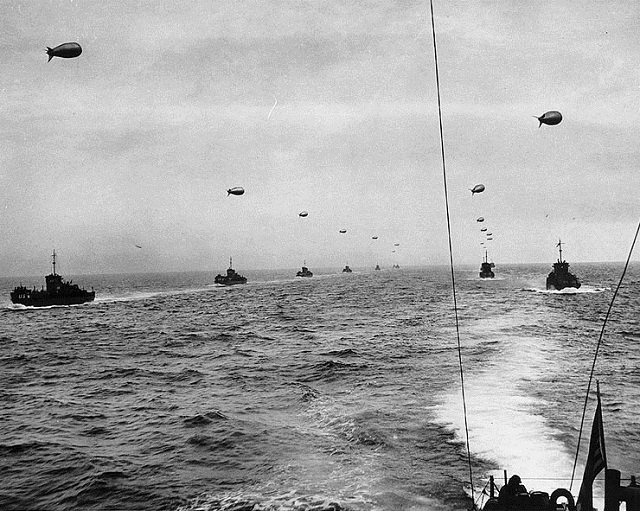 Large landing craft convoy crosses the English Channel on June 6, 1944.
Large landing craft convoy crosses the English Channel on June 6, 1944.
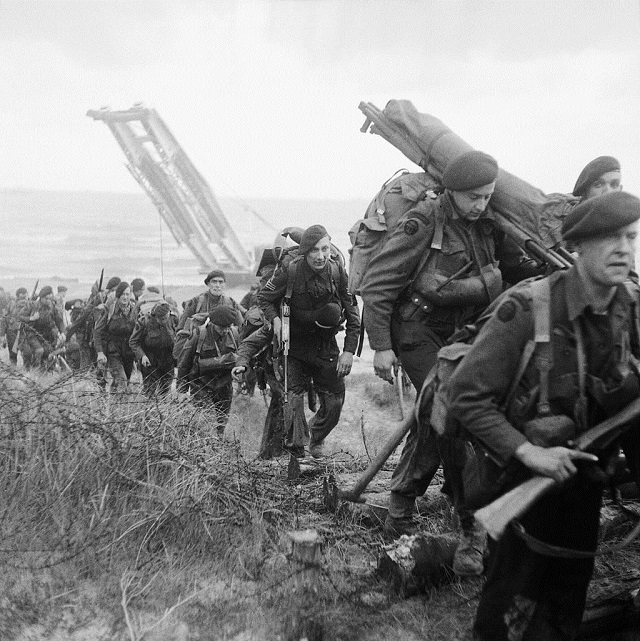 Royal Marine Commandos attached to 3rd Infantry Division move inland from Sword Beach, June 6, 1944.
Royal Marine Commandos attached to 3rd Infantry Division move inland from Sword Beach, June 6, 1944.
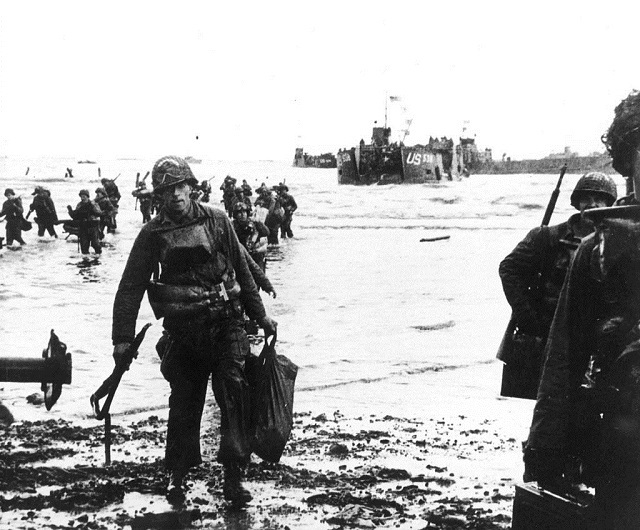 Carrying equipment, U.S. assault troops move onto Utah Beach. Landing craft can be seen in the background.
Carrying equipment, U.S. assault troops move onto Utah Beach. Landing craft can be seen in the background.
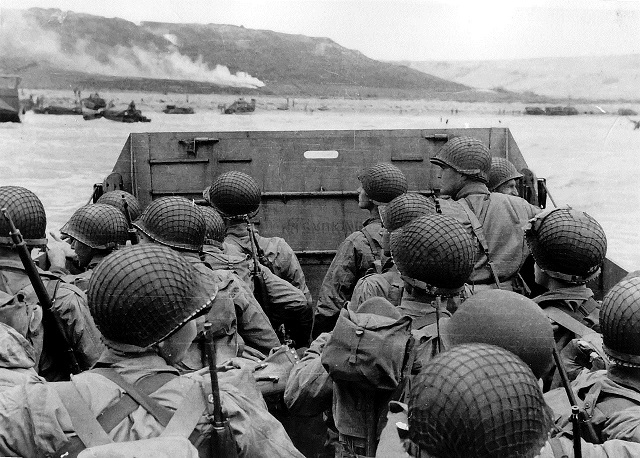 U.S. assault troops in an LCVP landing craft approach Omaha Beach, June 6, 1944.
U.S. assault troops in an LCVP landing craft approach Omaha Beach, June 6, 1944.
 British troops come ashore at Jig Green sector, Gold Beach.
British troops come ashore at Jig Green sector, Gold Beach.
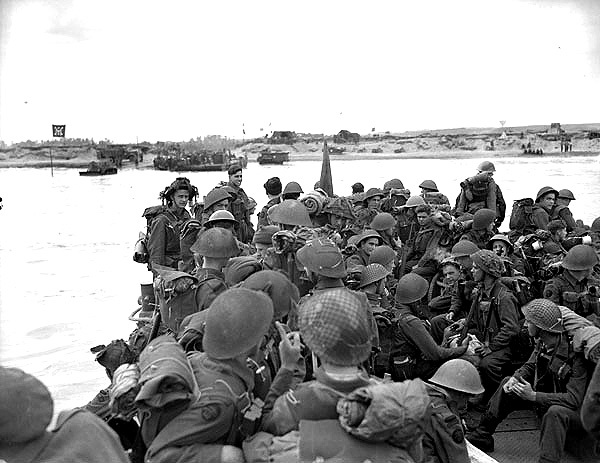
Personnel of Royal Canadian Navy Beach Commando "W" land on Mike Beach sector of Juno Beach, June 6, 1944.
 Meeting of the Supreme Headquarters Allied Expeditionary Force, February 1, 1944. Front row: Air Chief Marshal Arthur Tedder, 1st Baron Tedder; General Dwight D. Eisenhower; General Bernard Montgomery. Back row: Lieutenant General Omar Bradley; Admiral Bertram Ramsay; Air Chief Marshal Trafford Leigh-Mallory; Lieutenant General Walter Bedell Smith.
Meeting of the Supreme Headquarters Allied Expeditionary Force, February 1, 1944. Front row: Air Chief Marshal Arthur Tedder, 1st Baron Tedder; General Dwight D. Eisenhower; General Bernard Montgomery. Back row: Lieutenant General Omar Bradley; Admiral Bertram Ramsay; Air Chief Marshal Trafford Leigh-Mallory; Lieutenant General Walter Bedell Smith.
 The Bény-sur-Mer Canadian War Cemetery
The Bény-sur-Mer Canadian War Cemetery
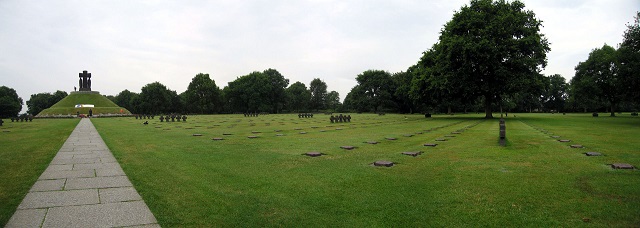 The La Cambe German war cemetery, near Bayeux
The La Cambe German war cemetery, near Bayeux
The opinions expressed herein are the author's and not necessarily those of The Maritime Executive.
